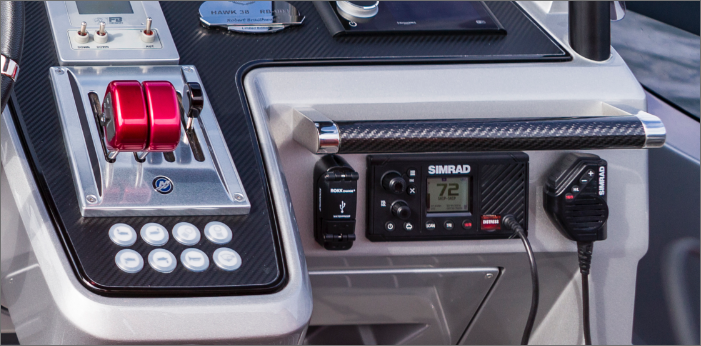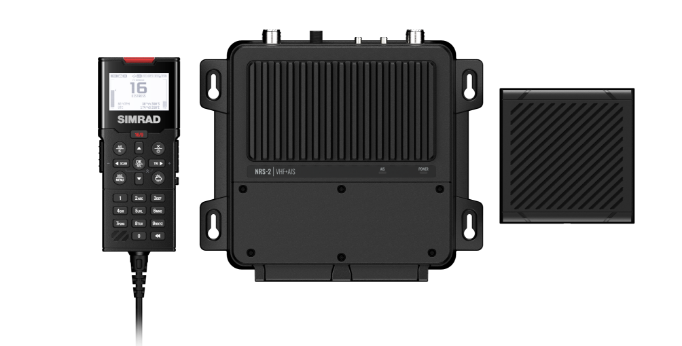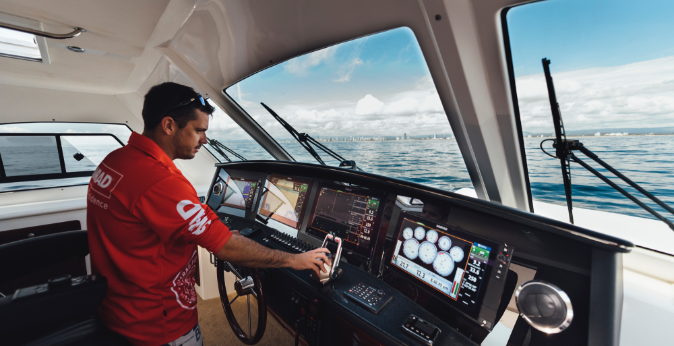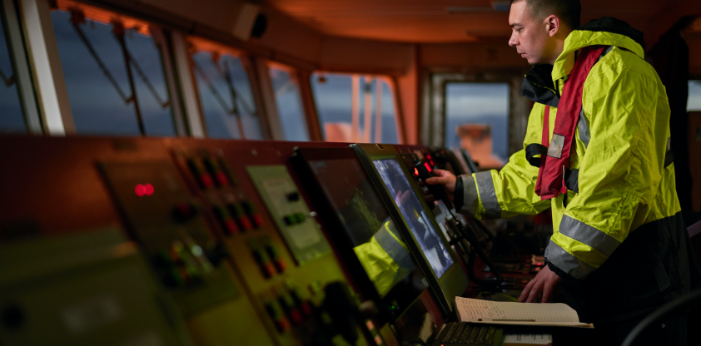About VHF radios
A VHF radio is arguably the first piece of marine electronics you are always going to want on your boat. It is a highly recommended (and in some cases legally required) piece of equipment. The latest VHF generations do much more than just enable you to communicate with others, as we’ll explore in this article.


What is a marine VHF radio?
At it’s most basic a VHF marine radio enables you to:
- Speak to other VHF radio operators by keying a press to talk (PTT) button on the mic
- Contact other stations using Digital Selective Calling (DSC) monitor transmissions from other vessels and shore-based stations
- Cut the white noise hiss arising from atmospheric electrical activity by using a ‘squelch control’ to keep you radio silent unless receiving a message
‘VHF’ stands for Very High Frequency, the part of the radio spectrum that marine sets operate on. You don’t need to manually tune the radio to a specific frequency because there is an internationally agreed set of FM band channels with allocated purposes and an identification channel number. You typically select these by up/down buttons.
Depending on where you do your boating, you may find a few additional channels that have specific purposes locally. A marine VHF radio sold in your country should have the right channels for your region.
The most important channel for audio use of a marine VHF is Channel 16. This is the international distress, safety and calling channel on which every VHF radio-equipped boat should keep a listening watch. However, depending on where you do your boating, there could be other important channels to be aware of, such as those governing important navigation areas like channels and controlled sea lanes.
Regulations also tightly govern how marine VHFs are made. Fixed sets fitted to boats typically offer the option to transmit at high power (25W) for the best possible range or low power (1W) where you only need to talk to a local station like a marina.
For portable and emergency use, you can also buy a handheld VHF. A handheld will only operate on 1W low power.
Range
The range of a marine VHF is not solely dependent on power. Except in unusual atmospheric conditions, a successful VHF radio transmission needs to have ‘line of sight’ where the send and receive antennas are theoretically visible to each other. The curvature of the earth is a factor, so the height of the transmitting and receiving antennas is important.
See also VHF - How to get the best out of your radio
As an example, if your boat’s antenna is at a height of 5m and the aerial of the boat you are communicating with is also at a height of 5m, then the theoretical maximum range is 18km (just under 10 nautical miles). If you were communicating with a shore-based station with it’s antenna at 10m then the distance would increase to 22km (12nm).
There are reasons why you won’t reach this theoretical maximum, such as the condition of your VHF and antenna, obstructions, weather conditions and even poor voltage levels at your radio. Conversely, you can get unusual infrequent conditions where the VHF signal bounces off the atmosphere and you hear stations from much further away than expected.

Regulations
Marine VHFs are tightly regulated to ensure that their safety effectiveness is preserved. Marine sets should never be used on land unless from a licensed station such as a harbour or coastguard office.
Conditions vary but depending on your country you may need:
- A VHF operator’s licence, which is commonly obtained by taking a simple course that will teach you the correct operation
- A boat or ship’s radio licence, for which you will need to apply to the relevant authority
More advanced functions
There are two important additional attributes that greatly expand the traditional function of a marine VHF:
GMDSS (Global Maritime Distress and Safety System) is an internationally agreed set of safety procedures, types of equipment and communication protocols. For marine VHFs used on leisure boats, the biggest impact of this system is the use of DSC (Digital Selective Calling) which sends and receives digital text messages. To use DSC, your boat will need an MMSI (Maritime Mobile Service Identity) which is typically issued by your national marine radio licensing authority. This is like a unique telephone number, permitting other boats within range to alert or message you. DSC capability will also provide audible and visual alarms of any distress calls. All Simrad® VHF radios have DSC as standard.
AIS (Automatic Tracking System) allows vessels to exchange navigation data about their identity, position, course and speed to assist traffic management. If you have an AIS receiver, you can capture data from AIS-equipped vessels around you and display them on your marine electronics. If you have an AIS transceiver, you will also broadcast your boat’s data, so you can more easily be detected by those around you. Simrad® VHF radios all come with a built-in AIS receiver or transceiver, depending on the model chosen.
What’s in the box
There are two main choices for marine VHFs installed on boats:
- Fixed-mount unit – this is a fully integrated unit that is typically bracket or fascia mounted. Just add an antenna and power for a basic installation. The Simrad® fixed mount units are supplied with a removable fist-mic but you can additionally specify wireless handsets.
- Integrated system – this type of installation features a black box that you can install out of the way, combined with wired handset stations and external speakers. Again, Simrad® offers wireless handset options.
You’ll also need:
- An antenna for VHF radio operation – due to the physics of transmission, these are supplied in lengths that correlate to the wavelength, typically 2.4m for a motorboat or 1.2m for smaller craft. The really long antennas you see on some boats are often 2.4m antennas with non-transmitting extensions at their base. As a rule of thumb always fit the best quality antenna and ensure you mount it on your boat vertically.
- A second antenna for AIS operation or a dedicated AIS antenna splitter unit (enabling the use of one antenna for VHF radio and AIS).
- A GPS receiver or interface connection to your integrated marine electronics so that the DSC and AIS services on your VHF have access to dynamic position information.
Simrad® also offers standalone AIS transceivers for boats that already have standard VHF sets.
What would I use my VHF radio for?
- Safety
- Communication
Taking each of these in turn:
Safety
Given we live in an era where mobile phones are everywhere, one might question a technology that first evolved at the turn of the last century. The first generation brick-style analogue phones could take a call many miles out to sea in the late 1980s. However, with each new generation of mobile phone technology, the data speed has got faster but the effective range to shore-based antennas has become shorter. The latest 5G technology is based upon closely-spaced cells and is likely to offer the worst range yet seen offshore.
Marine VHF radio therefore remains critically important as a way of alerting others if you experience a boat or medical emergency aboard. It also assists you in being able to listen out for distress, safety and navigation messages. Following a purchase, it is to all intents and purposes free, except for any local licensing costs.
Many boat owners will never experience a real Mayday situation, but the wealth of information you can gain from simply monitoring your radio will help to keep you safe, especially if you do your boating around busy shipping areas.
DSC builds on that capability, enabling enhanced range distress calling and more routine communication by text.
AIS enhances safety again, with it’s ability to gain an understanding of vessels around you and broadcast your own position. This is not a replacement for radar but a very good enhancement to it, adding an additional layer of data to assist your understanding of the picture around you.

Communication
A marine VHF set provides you with the ability to speak with the harbour office, bridge keeper, water taxi or friend on a nearby boat. It’s hard to visualise a boat without a VHF, such is it’s convenience in terms of being able to put you in touch with the people that count each time you get afloat.
As such, we’d always recommend at least one serviceable marine VHF should be high on your list of basic marine electronics.
More information
To learn more about the Simrad® VHF ranges, see :
















